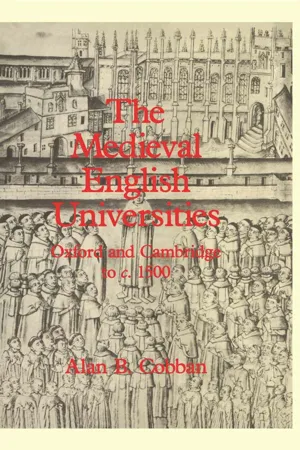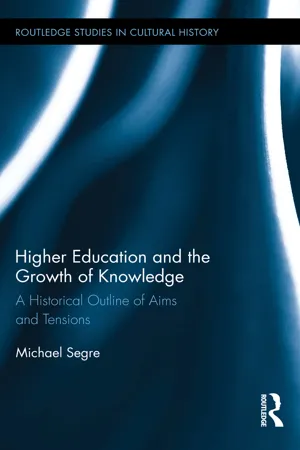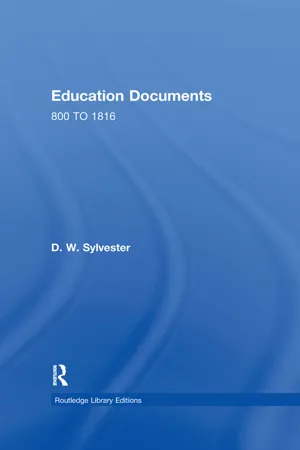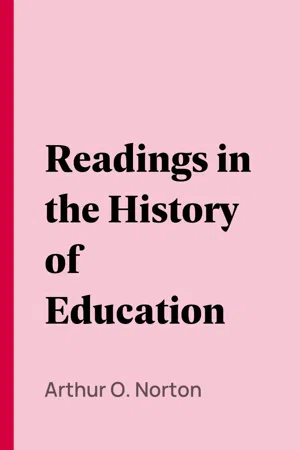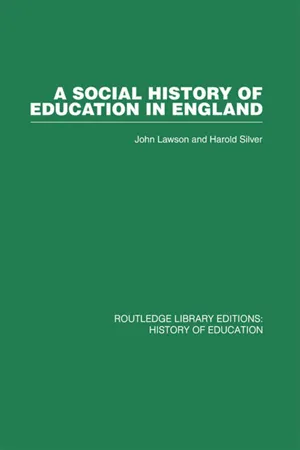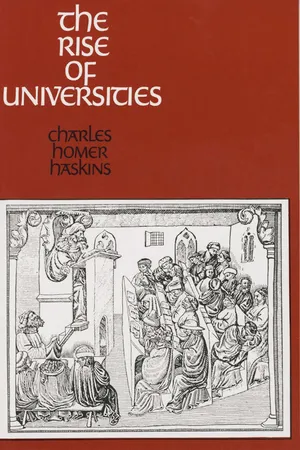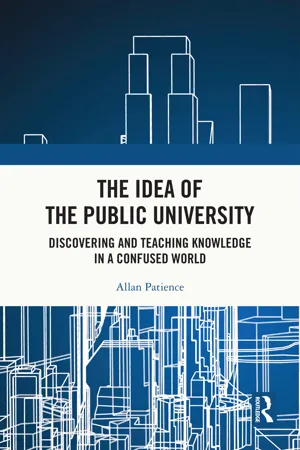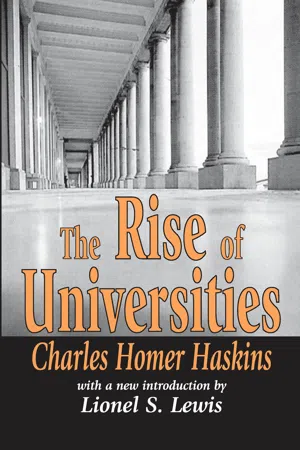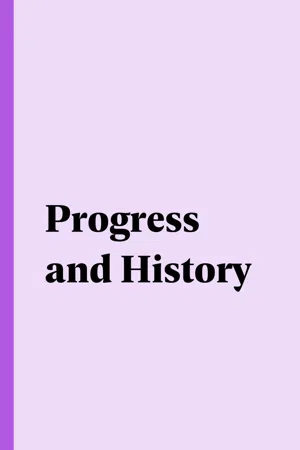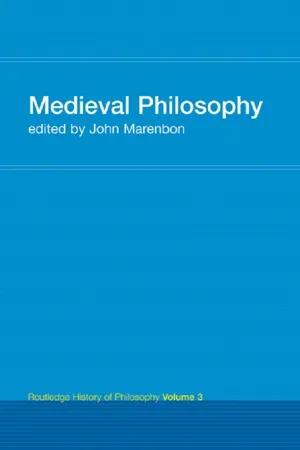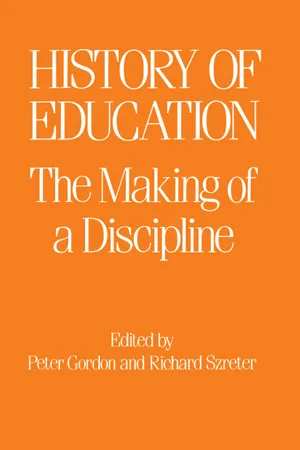History
Medieval Universities
Medieval universities were institutions of higher learning that emerged in Europe during the Middle Ages. They were typically founded and supported by religious institutions and played a key role in the development and transmission of knowledge, particularly in theology, law, and medicine. These universities laid the groundwork for the modern educational system and were influential in shaping intellectual and cultural life during the medieval period.
Written by Perlego with AI-assistance
Related key terms
11 Key excerpts on "Medieval Universities"
- eBook - ePub
The Medieval English Universities
Oxford and Cambridge to c. 1500
- Alan B. Cobban(Author)
- 2017(Publication Date)
- Routledge(Publisher)
Chapter 1 The Medieval University: The European ContextThe medieval university was primarily an indigenous product of western Europe.1 It is true that the Greek, the Graeco-Roman, the Byzantine and the Islamic worlds had produced centres of higher education in rich profusion, and that these may have prefigured features of the Medieval Universities, such as regular curricular arrangements, and produced tentative forms of organization among teaching staff,2 but they nowhere paralleled the Medieval Universities as privileged corporate associations of masters and students with their statutes, seals, administrative machinery and degree procedures.3 There appears, therefore, to have been no significant organic continuity between the universities which evolved in western Europe in the twelfth century and previous institutions of advanced learning. However much the universities owed to Graeco-Roman and Arabic intellectual life, their corporative character was a novel educational development, born of the need to expand the resources for professionally oriented education in an increasingly urbanized European society.The terminology concerning the Medieval Universities is a complicated issue. Only by accident did the Latin term universitas come to be specifically associated with university institutions.4 In the twelfth, thirteenth and fourteenth centuries, universitas was commonly applied in such a way as to denote several types of corporate bodies such as craft guilds or municipal councils.5 When used in relation to universities the term for long referred to the guild of masters or of students or of masters and students combined, that is to say, to the academic personnel and not to the university as a complete entity. It was only from the late fourteenth century that universitas began to be associated particularly with universities as distinct from other modes of corporation. And it came to be used increasingly, in less formal documentation, to designate the university structure as a whole and not merely its guild constituent.6 Before the fifteenth century, however, the abstract term which most frequently and formally rendered the medieval concept of a fully-fledged university was studium generale.7 - eBook - ePub
Higher Education and the Growth of Knowledge
A Historical Outline of Aims and Tensions
- Michael Segre(Author)
- 2015(Publication Date)
- Routledge(Publisher)
The 12th and 13th centuries saw the introduction of new works by Aristotle and fundamentals of Greco-Arab science. Albertus Magnus (c. 1200–1280) and his pupil Thomas Aquinas (1225–1274), who taught in several European universities, reconciled in their summae (“sum up” of knowledge—a medieval textbook) Christianity with Aristotelian philosophy into a relatively rigid learning. The development of knowledge, including that knowledge at the roots of modern science, was thus subject to religion in addition to corporatism. More in general, there was little or no awareness of the growth of knowledge, which was conceived as static and complete. Madkdisi (1981), as seen, points out many similarities between madrasa s and European Medieval Universities, in particular university colleges: structures, methods of learning, license to teach, and so forth. I would add the similarity between Jewish yeshivot and universities. Of course, there were many types of yeshivot, madrasa s, and European colleges, and there is no evidence of direct influence. Yet, to paraphrase Makdisi (1981, 286), it is inconceivable that three cultures developed side by side for centuries without being aware of developments on either side. Over time, medieval studia, with the teaching of the liberal arts, law, medicine, and theology, embraced virtually the totality of higher knowledge in the Middle Ages. The universities came to monopolize a large part of the knowledge, which was still circumscribed, in a society in which the majority of the population was illiterate. Only medicine could claim relative independence from religion, yet all the teachings, including medicine, were basically dogmatic. For a long time, medicine remained mainly a theoretical subject, separate from surgery, a practice that was considered less prestigious and was taught outside the university because it was a “trade” belonging to a lower social level - eBook - ePub
Education Documents
ENGLAND AND WALES 800 TO 1972
- D. W. Sylvester(Author)
- 2016(Publication Date)
- Routledge(Publisher)
Medieval UniversitiesIn Carolingian times Benedictine monasticism had been the main agent of learning and education in Western Europe. However, the reforming orders of the eleventh and twelfth centuries, such as the Cluniacs and the Cistercians, had the effect of turning the monasteries towards a more ascetic life in which learning figured less. The immediate successors to monasticism in providing education were the Cathedral schools, and in certain towns these became centres of learning great enough to become known and accepted as universities. No simple explanation can be offered for the growth of universities. The revival of trade, the growth of towns, a widespread intellectual restlessness and the appearance of a student population able and willing to wander in search of knowledge – all these factors need to be considered in attempting to explain the rise of the universities.In England the two universities which eventually established themselves did not rise from cathedral schools as the University of Paris did. Nevertheless Oxford and Cambridge were part of that European revival of learning which by 1500 had become institutionalized in the foundation of over seventy universities. The extracts which follow attempt to illustrate the general origins and features of universities as well as those peculiar to England.*PETER ABELARD (1079–1142)
The personality and teaching of Abelard were both a cause and a symptom of that upsurge of intellectual enquiry which eventually became institutionalized in the universities of the Middle Ages. The following extract, from a letter of Abelard, indicates his own studies and his climb to eminence as a teacher.… Moreover I had a father who had some training in letters before he put on the trappings of war. Wherefore later he grew so fond of literature that he was disposed to have all his sons instructed in letters before they were trained in arms. And so ’twas done. As therefore he held me his firstborn the more dear, so much the more pains did he take with my education. For my part, the more extensively and readily I progressed in literary studies, the more ardent became my devotion to them, and I was allured into such a passion for them that, surrendering to my brothers the pomp of military glory and my hereditary prerogative as firstborn, I totally abdicated the court of Mars to be received into the bosum of Minerva. And since I preferred the panoply of dialectical arguments to all the documents of philosophy, I exchanged other arms for these and esteemed the conflict of disputation more than the trophies of war. Whereupon traversing various provinces, disputing wherever I had heard that the pursuit of this art was flourishing, I became an emulator of the Peripatetics. - eBook - ePub
Readings in the History of Education
Mediaeval Universities
- Arthur O. Norton(Author)
- 2005(Publication Date)
- Perlego(Publisher)
3. Between the latter part of the twelfth century and 1500 A.D. at least seventy-nine universities were established in western Europe. There may have been others of which no trace remains. Several of them were short-lived, some lasting but a few years; ten disappeared before 1500. Since that date twenty others have become extinct. The forty-nine European universities of to-day which were founded before 1500 have all passed through many changes in character and various periods of prosperity and decline, but we still recognize in them the characteristic features mentioned above, and the same features reappear in the "most modern, most practical, most unpicturesque of the institutions which now bear the name of 'University.'" This is one illustration of the statement on page 2 that the daily and hourly conduct of university affairs in the twentieth century is to a surprising degree influenced by what universities did seven centuries ago.4. The term "University" has always been difficult to define. In the Middle Ages its meaning varied in different places, and changed somewhat in the centuries between 1200 and 1500 A.D. In these pages it signifies in general an institution for higher education; and "institution" means, not a group of buildings, but a society of teachers or students organized, and ultimately incorporated, for mutual aid and protection, and for the purpose of imparting or securing higher education. Originally, universities were merely guilds of Masters or Scholars; as such they were imitations of the numerous guilds of artisans and tradesmen already in existence. Out of the simple organization and customs of these guilds grew the elaborate organization and ceremonials of later universities.There were two main types of university organization,—the University of Masters, and the University of Students. In the former,—which is the type of all modern universities,—the government and instruction of students were regulated by the Masters or Doctors. In the latter, these matters were controlled by the students, who also prescribed rules for the conduct of the Masters. Paris and Bologna were, respectively, the original representatives of these types. Paris was the original University of Masters; its pattern was copied, with some modifications, by the universities of England, Germany, Denmark, Sweden, and Scotland. Bologna was the archetypal University of Students; its organization was imitated, also with variations, by the universities Italy, France (except Paris), Spain, and Portugal. - eBook - ePub
- John Lawson, Harold Silver(Authors)
- 2013(Publication Date)
- Routledge(Publisher)
Their function was both ideological and professional: they set themselves to interpret and defend Catholic doctrine, and also to train men for the service of church and state in its widest sense. The men they produced were in great demand. Already in the thirteenth century university graduates – the magistri – dominated the ecclesiastical hierarchy. Of 78 bishops between 1215 and 1272 no fewer than 40 were magistri.[ 26 ] From this time until the early sixteenth century secular as well as ecclesiastical administration was largely in the hands of an intellectual and managerial élite of graduate clerics, rigorously trained in arts and often in law or theology: it was perhaps as training grounds for government service that the universities exerted their greatest influence on society. Thus the early universities did not aim to provide general academic culture for a social élite; they were centres of professional training – equipping men for careers as teachers, preachers, civil and canon lawyers, officials and administrators. Nor did they exist to pursue knowledge for its own sake or to prosecute research in any modern sense. Society generally and students individually could not afford these intellectual luxuries. In any case, in orthodox medieval thought the truth was not to be discovered by free inquiry and experiment: it existed in the Scriptures, the Fathers, Aristotle and other texts of unimpeachable authority, and it had to be extracted and interpreted by logic and reason in lectures, questionings and disputations. However, this could not have been all the education that the universities afforded. They were centres of vigorous adolescent life as well as of teaching and learning - eBook - ePub
- Charles Homer Haskins(Author)
- 2013(Publication Date)
- Cornell University Press(Publisher)
Then the faculties, four or more, with their deans, and the higher officers such as chancellors and rectors, not to mention the college, wherever the residential college still survives. The essentials of university organization are clear and unmistakable, and they have been handed down in unbroken continuity. They have lasted more than seven hundred years—what form of government has lasted so long? Very likely all this is not final—nothing is in this world of flux—but it is singularly tough and persistent, suited to use and also to abuse, like Bryce’s university with a faculty “consisting of Mrs. Johnson and myself,” or the “eleven leading universities” of a certain state of the Middle West! Universities are at times criticised for their aloofness or their devotion to vocationalism, for being too easy or too severe, and drastic efforts have been made to reform them by abolishing entrance requirements or eliminating all that does not lead directly to bread and butter; but no substitute has been found for the university in its main business, the training of scholars and the maintenance of the tradition of learning and investigation. The glory of the mediaeval university, says Rashdall, 9 was “the consecration of Learning,” and the glory and the vision have not yet perished from the earth. “The mediaeval university,” it has been said, “was the school of the modern spirit.” How the early universities performed this task will be the theme of the next lecture. 1 H. Denifle, Die Enstehung der Universitäten des Mittelalters bis 1400, vol. I (Berlin, 1880). 2 H. Rashdall, The Universities of Europe in the Middle Ages, 2 vols. in 3 (Oxford, 1895); rev. ed., 3 vols. (Oxford, 1936). Later references to this book are to the 1936 edition. 3 Trans, by L. Thorndike, University Records and Life in the Middle Ages (New York, 1944), pp. 35–39. 4 As translated by D. C. Munro, The Mediaeval Student (University of Pennsylvania, Translations and Reprints; Philadelphia, 1899), p - eBook - ePub
The Idea of the Public University
Discovering and Teaching Knowledge in a Confused World
- Allan Patience(Author)
- 2022(Publication Date)
- Routledge(Publisher)
Jayapalan, 2005 ).Conclusion
This growth of universities around the world in the nineteenth centuries drew from long history of sanctuaries of scholarship that had sheltered men and women of contemplation, thoughtfulness and intellectual curiosity all down the ages and across much of the globe. As Marcia Colish concludes in her excellent study of the Medieval Foundations of the Western Intellectual Tradition: “[T]he central lesson every field conveyed to later ages is that it is possible, and desirable, to invent and to reinvent ideas and aesthetic forms of expression, maintaining an organic connection with tradition while using it to fuel a continuous process of intellectual self-fashioning” (1997 : 359). Well before medieval times, in Asia and Africa and across Europe, thinkers had been questioning conventional beliefs and orthodox dogmas about their societies and their place in the world – wondering about how they came into being, and why. Communities were formed providing sanctuary for these people, allowing them time, resources, and space for nurturing their questioning and imagining.The earliest idea of a university, then, is of a place of sanctuary, a place where it is safe to think deeply and seriously, reverentially, and critically, a place where original thought could flourish. It was also a place where truth – however subtly expressed – could be spoken to power. In Oxford, in the nineteenth century, John Henry Newman was one of the beneficiaries of this great scholarly tradition. Building on ideas that had already been fermenting in the eighteenth century through the writings of thinkers such as Adam Smith and Immanuel Kant, he began re-imagining the idea of a university in ways that would influence the development of the modern liberal university into the twentieth century. Though increasingly under critical scrutiny, his thinking is still relevant for defending a culture of liberal learning in the university of today. - eBook - ePub
- Charles Homer Haskins(Author)
- 2017(Publication Date)
- Routledge(Publisher)
It is, then, in institutions that the university tradition is most direct. First, the very name university, as an association of masters and scholars leading the common life of learning. Characteristic of the Middle Ages as such a corporation is, the individualistic modern world has found nothing to take its place. Next, the notion of a curriculum of study, definitely laid down as regards time and subjects, tested by an examination and leading to a degree, as well as many of the degrees themselves — bachelor, as a stage toward the mastership, master, doctor, in arts, law, medicine, and theology. Then the faculties, four or more, with their deans, and the higher officers such as chancellors and rectors, not to mention the college, wherever the residential college still survives. The essentials of university organization are clear and unmistakable, and they have been handed down in unbroken continuity. They have lasted more than seven hundred years — what form of government has lasted so long? Very likely all this is not final — nothing is in this world of flux — but it is singularly tough and persistent, suited to use and also to abuse, like Bryce’s university with a faculty “consisting of Mrs. Johnson and myself,” or the “eleven leading universities” of a certain state of the Middle West! Universities are at times criticised for their aloofness or their devotion to vocationalism, for being too easy or too severe, and drastic efforts have been made to reform them by abolishing entrance requirements or eliminating all that does not lead directly to bread and butter; but no substitute has been found for the university in its main business, the training of scholars and the maintenance of the tradition of learning and investigation. The glory of the mediaeval university, says Rashdall, was “the consecration of Learning,” and the glory and the vision have not yet perished from the earth. “The mediaeval university,” it has been said, “was the school of the modern spirit.” How the early universities performed this task will be the theme of the next lecture.1 As translated by Munro, The Mediaeval Student, p. 19.1 Translated in E. F. Henderson, Select Historical Documents of the Middle Ages, pp. 262—266.2 Table in Rashdall, Universities, I, p. xxviii; map at beginning of Vol. II and in Shepherd, Historical Atlas - eBook - ePub
- (Author)
- 2009(Publication Date)
- Perlego(Publisher)
In the second place it is important, and especially I think in these days, to understand that the men who thus created the universities in their eagerness to learn, were of every class and condition, rich and poor, noble and simple, and they lived as they could, in comfortable quarters if they were wealthy men, or in the garrets and cellars of the citizens if they were poor, and for the most part they were poor; but neither poverty nor riches could destroy their noble thirst for knowledge. The life of the universities was indeed turbulent and disorderly, the students were always at war with the citizens, and, when they were not breaking the heads of the citizens or having their heads broken by them, they were at war with each other, the men of the north with the southerners, the western with the eastern; for the universities were not local or national institutions, but were made up of a cosmopolitan crowd of men of every nation in Europe, intelligible to each other, as unhappily we are not, by the universal knowledge and use of that mediaeval Latin, which might distress the Ciceronian ears of a pedant of the Renaissance, but was a good, useful, and adaptable language. It was a turbulent, disorderly, brutal, profligate, and drunken world, for the students were as hard drinkers as the citizens, but it was animated, it was made alive by a true passion for knowledge, by an unwearied and never satisfied intellectual curiosity.But it will be asked, what did they learn? Well, the only answer that one can give is that they learned whatever there was to learn. Our literary friends have often still the impression that in the Middle Ages men spent their whole time in learning theology, and were afraid of other forms of knowledge, but this is a singular delusion. As the universities developed a system, their studies were arranged in the main under four heads, the general studies of what came to be called the Faculty of Arts, and the professional studies of the three superior Faculties of Law, Medicine, and Theology, but the student was not normally allowed to study in the three superior Faculties until he had spent some years in the studies of the Faculty of Arts. It is therefore with this latter that we are primarily occupied. The studies in the Faculty of Arts consisted, to use our modern terminology, of literature, philosophy, and science, and the accomplished mediaeval student was expected to know whatever there was to know. - eBook - ePub
Routledge History of Philosophy Volume III
Medieval Philosophy
- John Marenbon, John Marenbon(Authors)
- 2003(Publication Date)
- Routledge(Publisher)
CHAPTER 8 The intellectual context of later medieval philosophy: universities, Aristotle, arts, theology
Stephen BrownORIGIN OF THE UNIVERSITIES
A number of medieval towns in the twelfth century owed a large portion of their renown to their schools. Chartres was both respected and criticized for its efforts to reconcile Plato and Aristotle. Reims was a centre for the study of Scripture and the Fathers. Anselm of Laon brought fame to his home as a centre of developing theology. Paris was a magnet attracting famous teachers: Abelard, the dialectician and theologian; Hugh, Richard, and Andrew of St Victor, who brought to their Parisian abbey a justly respected name in the study of Scripture and a reverential awe for its level of mysticism; and Peter Lombard, whose Sentences became, from the thirteenth to the sixteenth century, the ordinary textbook of theology. Toledo's cathedral school became a place of contact between the Christian and Muslim intellectual worlds and offered a home for translators and commentators. In that school Dominic Gundissalinus, Gerard of Cremona, the Scotsman Michael Scotus, and the Englishman Alfred of Sareschal provided translations of Aristotle and his Islamic commentators that would later serve as key curriculum texts in the nascent universities.1 Bologna grew famous for the study of law, owing mainly to the stature of the legal advisers of Frederick Barbarossa and to the masters who explained Gratian's great canonical collection, the Decretum . Salerno drew students for medicine owing to the fame of Constantine the African, translator of the Articelli or Art of Medicine - eBook - ePub
The History of Education
The Making of a Discipline
- Peter Gordon, R. Szreter(Authors)
- 2012(Publication Date)
- Routledge(Publisher)
longue duree. For universities are one of the oldest forms of corporate organization in the West. Few institutions have been at once so fragile and so durable; few have been altered so radically, both internally and in their relationship to the larger society, adding new purposes, allowing others to lapse, and managing to maintain some of those for which they were originally founded. And perhaps because their existence and purpose presuppose an acute sense of the past, universities are rich repositories of information about themselves.No scholar working alone can expect to take full advantage of these vast sources, nor can he exploit on his own that unique opportunity for the investigation of long-term problems offered by the university as a subject of study. The new institutional history demands collaborative efforts which will press into service the methods of several disciplines as well as the computer.One such project, under the direction of Allan Bullock and T.H. Aston, is concerned with the social history of Oxford University from earliest times to the present. Another collaborative study, a statistical survey of universities in the West, is under way at the Shelby Cullom Davis Center for Historical Studies of Princeton University. A major goal of the project is to explore the cyclical patterns of expanding and contracting enrollments in Western universities, a phenomenon whose causes are not understood. Universities in England, Spain, and Germany exhibited similar patterns of rising enrollments in the sixteenth and early seventeenth centuries, of rapid decline beginning in the mid-seventeenth century, and of stagnation throughout the eighteenth. English and German enrollments again rose sharply in the nineteenth century. Was there a general decline in university matriculation throughout the West between about 1650 and 1800? If so, what were its causes, and what were its social, cultural, economic, and political consequences? Why did expansion resume in the nineteenth century? How did these cycles affect the pace and character of modernization in the West?
Index pages curate the most relevant extracts from our library of academic textbooks. They’ve been created using an in-house natural language model (NLM), each adding context and meaning to key research topics.
